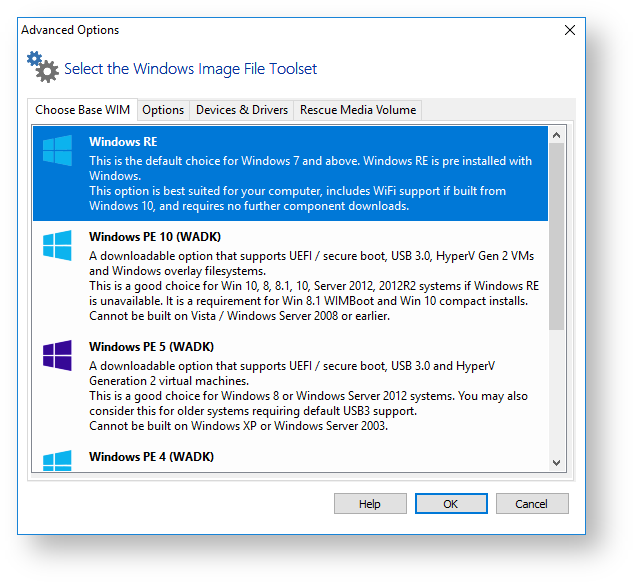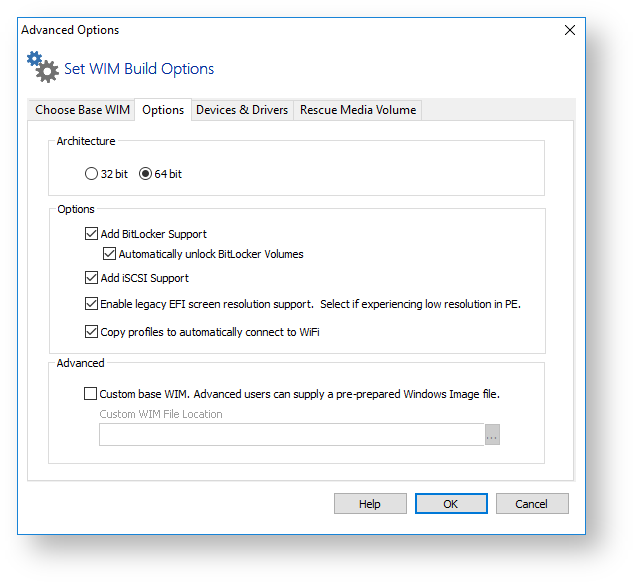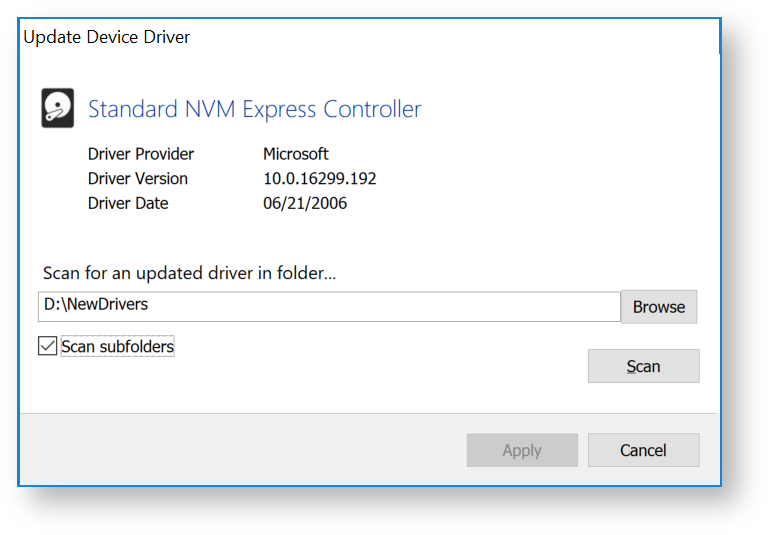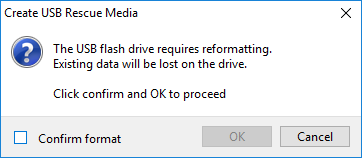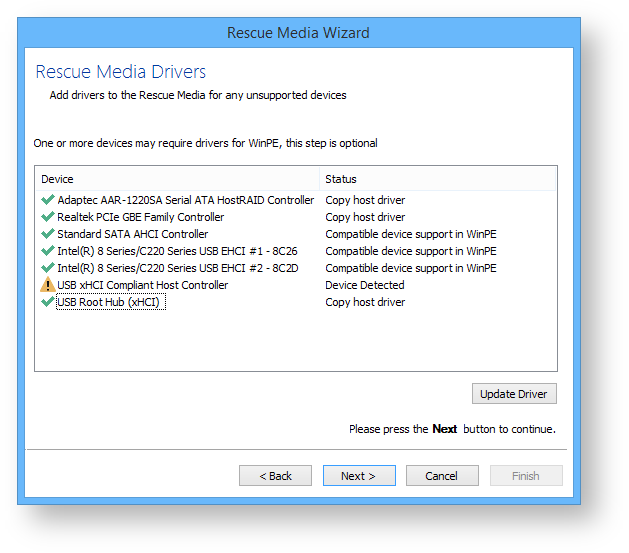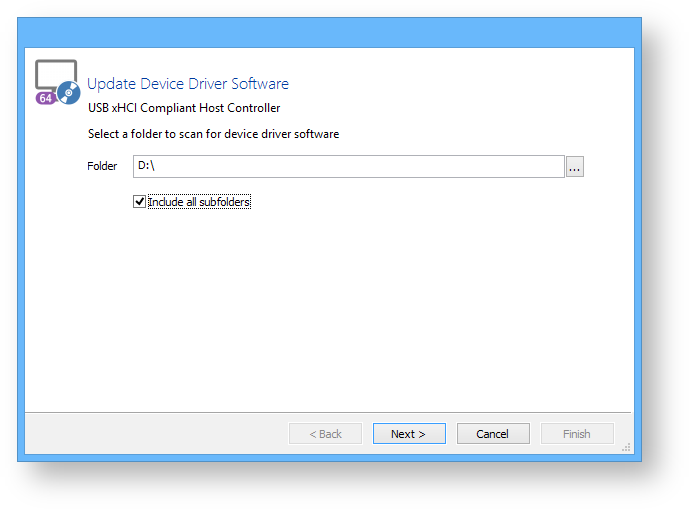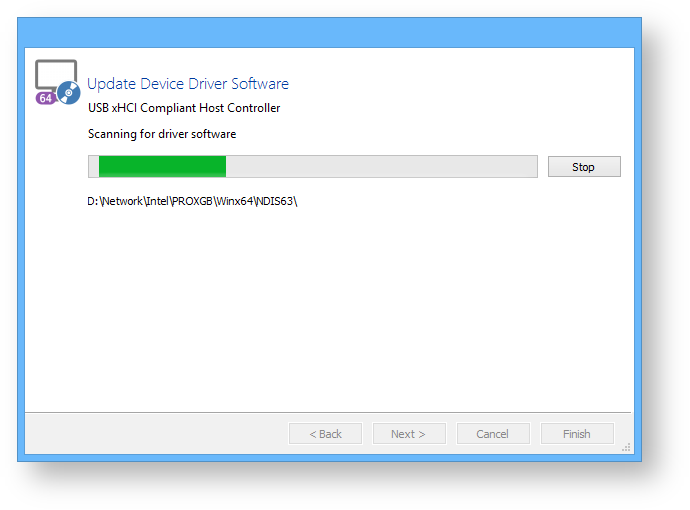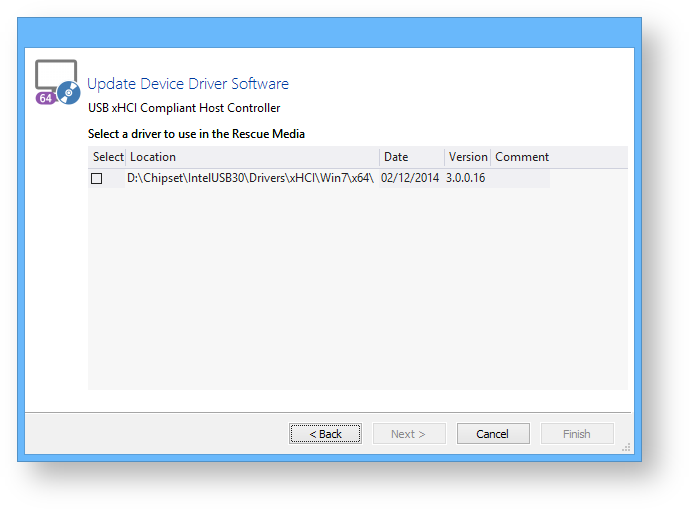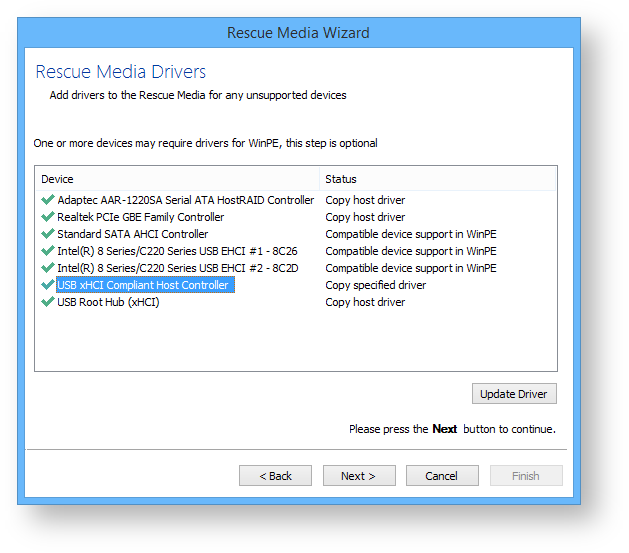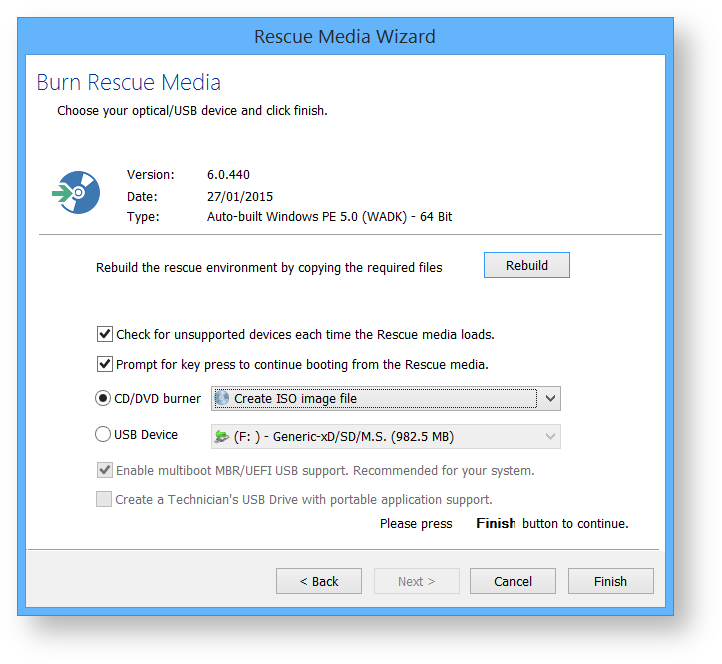The Rescue Media Wizard
- Insert your blank CD, DVD or USB stick.
From the Backup tab of the task pane, below Other Tasks, click Create bootable Rescue media.
Accept the default Windows PE environment selected by Macrium Reflect or Click 'Change PE Version' to use a different version of Windows PE for your rescue media:Click Next and add device drivers if required.
This dialog enables you to add drivers for any Network and Disk controllers that are unsupported in Windows PE.A device driver is a collection of files (also referred to as a driver package) and generally comprises of:
- The driver software, these files have a .SYS extension.
- The driver information, or INF, file which contains the installation instructions for the drivers, these files have a .INF extension.
- An optional security catalog that signs those drivers for operating systems that require signed drivers, commonly used on x64 operating systems, these files have a .CAT extension.
- One or more optional supporting software library files (Dynamic Link Library) that contain further code to support the driver software, these files have a .DLL extension.
Windows PE (WinPE) is packaged with a large collection of drivers but there are many devices that are not part of the WinPE driver package. If your device is not compatible then you must add its driver so WinPE recognizes it and communicates with your device.The wizard checks whether your device requires drivers adding to WinPE. It builds a list of devices in your computer that are either Hard Drive/RAID controllers, Network Interface Cards, USB controllers or USB hubs. For each of these devices it checks if:
- The device is supported by default in WinPE
- There is a compatible driver in the host operating system
- There is a compatible driver already present in the collection of drivers on previously created rescue media
Click Next. to prepare and build the Windows PE image
Note: If you have already built the Windows PE image for this rescue media then the wizard will skip this step and advance to the Burn pageOption Description PE Architecture Either 32 bit or 64 Bit. The default option is selected to match the architecture of the host Windows OS. Include optional components Select this option to add BitLocker Encryption and iSCSI support to the rescue media. Please note that adding these components may several minutes to the creation process.
See Adding iSCSI support to Windows PE for more information on using iSCSI in Windows PEAutomatically unlock BitLocker encrypted drives Select this option to automatically unlock all BitLocker encrypted drives when Windows PE starts.
See Adding BitLocker support to Windows PE for more information on using Windows PE to access BitLocker encrypted drives.Default base WIM Use the standard Microsoft Windows PE base installation. Macrium Reflect executables will be added to this to crate the rescue media, Custom Base WIM Use your own customized WIM for the rescue media. This is an advanced topic not covered in this help. Click Next to begin the WIM build process. If necessary, files will automatically be downloaded from Microsoft to complete the build process.
You can also select the PE Components .zip file by clicking the 'Browse' button in the download dialog. The PE .zip file can be downloaded by using the Reflect download agent 'ReflectDL.exe'.
See Installing anInstalling and updating Macrium Reflect offlined updating Macrium Reflect offline for more information on downloading the PE components separately.
A detailed log of the build process is saved to: 'C:\ProgramData\Macrium\waik\waiklog.txt'Once complete you can choose where to burn the media
Option ________________ Description Rebuild Click this button to advance to the 'Prepare Windows PE image' wizard page to rebuild the Windows Image (WIM).
Note: If updates are available for your rescue media then you will receive a message box prompting you to rebuild.Check for unsupported devices Select this option and Windows PE will prompt to add drivers for unsupported Network Interface and Disk controllers when started. Prompt for key press Select this option to enable the 'Press any key to boot from CD or DVD...' prompt when your PC starts. This is useful if you want to bypass Windows PE and boot into your host Windows OS. CD/DVD burner Select this option to choose a CD/DVD device that you are using to create your rescue media.
To save the rescue media to an .ISO image file for burning with any burning software. Click the drop-down list of burners and select 'Create an ISO image file':USB Device Select this option to save your rescue media to a bootable USB stick or external hard drive. Enable multiboot MBR/UEFI Only applies if you are saving your rescue media to a USB device. This option enables the USB device to boot both legacy MBR and GPT/UEFI for modern motherboards. Please consult your motherboard user manual for information on choosing these boot options at PC startup.
Note: CD/DVD media is always created multi-boot MBR/UEFITechnicians USB Applies to Macrium Reflect Technicians license keys only. See Technicians portable application support for more information Click Finish.to create your rescue media
To complete the process, boot from your Rescue media to ensure it works correctly.
After Windows PE loads, Macrium Reflect runs. The Windows PE user interface for Macrium Reflect is identical to that of the main application and offers the same core functions.
If you are using USB media, you can make the Macrium Rescue Environment compatible with multiple computers:
- Use the Rescue media wizard to create a bootable USB rescue device on one computer.
- Repeat the process with each other computer in turn using the same USB device.
Once I have created rescue media, will it work on all my computers?
If the hardware for all your computers is supported by the default Windows PE driver set, then the answer is a simple yes. You can confirm this on the Rescue Media Wizard drivers page. If all the drivers listed have the status Device support in WinPE or Compatible device support in WinPE for each of your machines then you only need one rescue media.
If any of your machines require extra drivers, then you have three options:
- Create one piece of rescue media for each machine.
- Invoke the Create Rescue Media Wizard on each of your machines.
- Locate all the necessary drivers and progress to the Rescue Media Burn page before canceling.
- Copy the contents of
folder 'C:\boot\macrium\drivers' from each machine to one machine. - Burn a Rescue CD on that machine.
- Locate all the necessary drivers and progress to the Rescue Media Burn page before canceling.
- Using the Rescue media wizard, create a bootable USB stick, inserting the same device on each machine in turn.
Note: Options 2 and 3 only work if all your machines are configured to use the same version of PE with the same architecture (i.e. they are all 32-bit or all 64-bit).
If my rescue media refuses to boot, what should I do?
Verify your CD
Try as many of the following steps as possible:
- Try booting the CD on a 2nd PC.
If it boots, this indicates a configuration or hardware issue with your PC. Please see Verifying your PC later in this article. - Try a different brand of CD media.
We have found that CD recordable media is of variable quality. Often, using different media will resolve your issue. - Try creating the rescue media on a 2nd PC.
If Reflect is installed on the 2nd PC, please try creating rescue media there.
Alternatively, following the same CD creation steps as before, select Create ISO image file on the last page of the wizard. Transfer this to the 2nd PC and us a third party utility such as ImgBurn to burn the CD.
In each case, try booting the 1st PC with the new CD.
Verify your PC.
To boot rescue media from CD, your BIOS or UEFI firmware must be correctly configured and have hardware suitable for booting. Please try as many of the following steps as possible to diagnose this.
Note that there is no standard for motherboard firmware configuration, so our instructions are necessarily non-specific. Please consult your motherboard manual for details relevant to your PC.
- Try booting a Microsoft Windows install CD.
If the boot fails, this is indicative the your hardware is incorrectly configured. Please continue through this list for further diagnosis. - Invoke your BIOS/UEFI boot menu.
Boot menus vary in appearance and are invoked in different ways. You may need to refer to your motherboard manual to find the key combination to access this. Sometimes, this is displayed on the screen and is usually a key such as DEL, F8, F11, F12, F2 etc.
Please note that on UEFI/BIOS dual systems, you may be given the option to boot UEFI or not for each device. Please boot the type matching your installed OS. There are a few possible outcomes:- You are able to boot your rescue media in this manner, but not without performing this step. In this case, please see the next step in this section.
- You are unable to boot your rescue media having seen the hardware in the menu. In this case, you may wish to try the Verify CD steps above. If these do not rectify the issue, your hardware may not support booting Windows PE (you can also try this with the Windows Install CD to verify). In this case, please try an alternative rescue media format such as USB, or attach a different CD/DVD drive to the system.
- You are unable to see the hardware in your list. In this case your firmware has not recognised the device and it is not supported for booting.
- You are able to boot your rescue media in this manner, but not without performing this step. In this case, please see the next step in this section.
- Change the motherboard boot order.
Please enter your BIOS or UEFI firmware setup utility and navigate to the "boot order" or "boot menu" equivalent screen. Please ensure CD/DVD booting has a higher priority than your hard disk, which may be labelled ATAPI, SATA, SCSI or various other labels depending on your system. Please press F10, or your equivalent for "save and exit" to reboot the system with the new priority.
Please note that some UEFI firmware may not have boot priorities for removable media, or booting from removable media may be a configurable option that you must enable. - Create a USB rescue stick.
Follows the same steps as used when creating a CD, selecting instead "USB media" on the last page. If this works and your have verified your CD, it is indicative that your hardware cannot boot a CD. However, a usb stick, is just as functional as a CD, so we recommend you use this as your rescue device. - Confirm that the CPU architecture of the PE media is compatible with your system
For BIOS/MBR systems, in general, a PC with boot either a 32 and 64bit PE.
For EFI systems, the PE architecture must match the system type. A 32bit EFI CD will only boot on 32bit EFI systems and visa versa. Apart from a few tablet devices, all EFI systems are 64bit only.
What to expect when booting rescue media.
- The PE 3.1 environment is based on (a cutdown version of) Windows 7 and so boots in a similar fashion.
- The PE 4.0 environment is based on Windows 8 and so boots in a similar fashion.
- The PE 5.1 environment is based on Windows 8 and so boots in a similar fashion.




